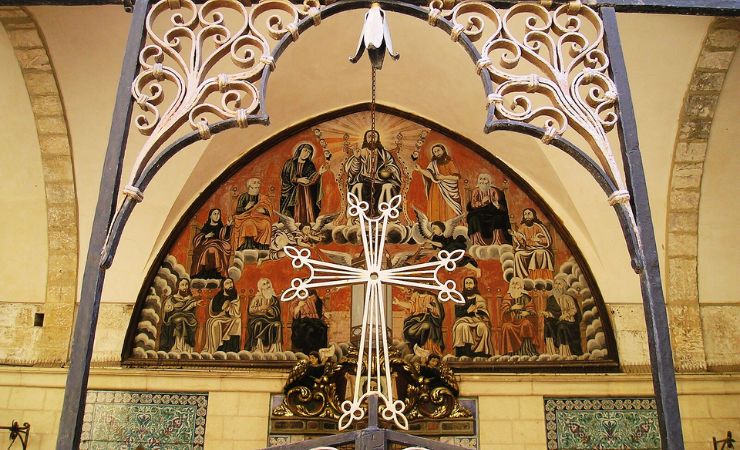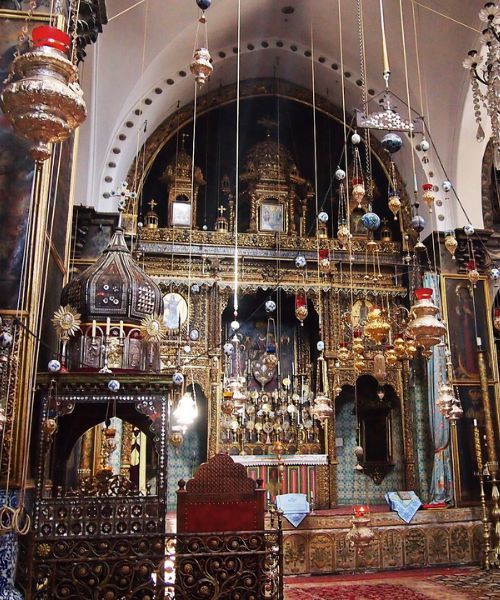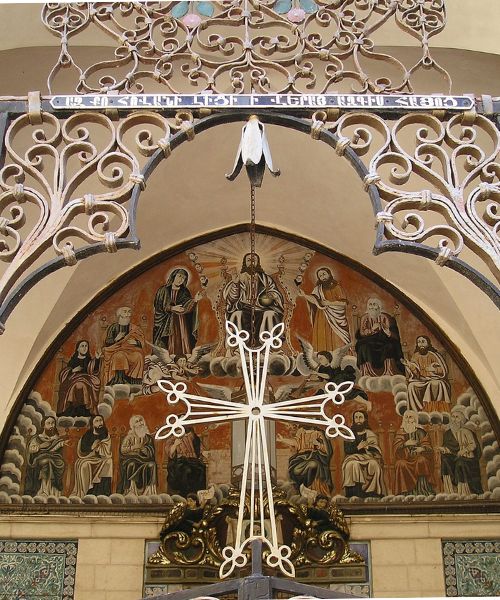The Church of St. James: An Armenian Jewel in Jerusalem's Old City
Introduction
The Church of St. James is part of the Armenian Orthodox Patriarchate of Jerusalem. It is one of the most ornately decorated places of worship in the Holy Land.
Location
The church is located in the West of the Old City of Jerusalem and is part of the Armenian Quarter.

The Church of St. James' Rich History
Armenia was the first nation to adopt Christianity as its state religion in 301 CE. The Armenian Christians were the first to establish a “quarter” in Jerusalem, marking the beginning of a long and enduring presence in the city.
The church is dedicated to two martyred saints of the same name — St. James the Great, one of the first apostles to follow Jesus, and St. James the Less, believed to be the brother of Jesus, who became the first bishop of Jerusalem. Both saints met tragic ends: St. James the Great was beheaded by Herod Agrippa I around 44 CE, while St. James the Less was martyred by Temple authorities about 20 years later.
According to Armenian tradition, the church houses the head of St. James the Great (the rest of his body is believed to be in the Spanish pilgrimage shrine of Santiago de Compostela) and the body of St. James the Less.
The cathedral was completed in the 12th century, during the reign of Melisende, Queen of Jerusalem, making it one of the few remaining Crusader-era churches in the Holy Land to have survived intact. It is a valuable piece of architectural history and a testament to the enduring presence of the Armenian community in Jerusalem.
Architectural Splendor - The artium
Just before entering the Church of St. James, visitors pass through a closed court, also known as an atrium. This open space is adorned with various elements of Armenian art and history. The walls of the atrium are decorated with stone crosses and inscriptions, known as “Katshkerim”. These inscriptions are in the Armenian alphabet, which was initially devised by Gregory the Illuminator and formally defined in 405/406 CE.
Significantly, the atrium is also the final resting place of the two saints to whom the church is dedicated. According to tradition, the tomb of St. James the Apostle, the brother of St. John the Evangelist, is located to the right, and the tomb of St. James, the brother of Jesus, is located to the left. These tombs add a profound spiritual significance to the atrium, serving as a reminder of the martyred saints and their connection to the church.
Architectural Splendor - the Church
The church’s interior provides a splendid spectacle of gilded altars, massive chandeliers, myriad lamps with ceramic eggs attached to them, paintings, carved wood, inlaid mother-of-pearl, bronze engravings, and blue and green wall tiles. The marble floor is usually covered with purple, green, and red carpets, adding to the vibrant color palette.
The cathedral’s mystical Eastern character is further enhanced during services by rich vestments, incense, and chanting. High-set windows, oil lamps, and candles are the only light sources, as there is no electricity. This creates a unique atmosphere where sunlight produces dazzling reflections on the church’s treasures, while cloudy days cloak the interior in darkness.
Ceiling decorations: The ceiling of the Chapel of Etchmiadzin boasts exquisite decorations consisting of hanging ceramic eggs created in Kütahya. Additionally, Kütahya ceramics in the form of tiles adorn the chapel, adding to its beauty. These ceramics were initially intended for the restoration of the Church of the Holy Sepulchre in 1719. However, due to a change in plans, they found their way to the Cathedral of Saint James, where they now decorate the ceilings.
Chapels: The church has a few chapels. The small Chapel of St. James the Great, located on the left side of the church, is its most important shrine. Also on the left side are doors leading to other chapels that are seldom open to visitors. Further forward, the Church of St. Stephen serves as the cathedral’s sacristy and baptistery.
Thrones: In the front of the cathedral are two thrones. The larger is dedicated to St. James the Less. A low iron grille behind it encloses the saint’s reputed burial place. The smaller throne is the seat of the Armenian Orthodox patriarch.



The Armenian Quarter: A Living History
The compound of St. James Convent, which contains the Church of St. James, is like a miniature city with residences for more than 1,000 families. Behind its fortress-like walls are the patriarchate, a hospice, living quarters for nuns and priests, a school, social clubs, and a printing press — the first in Jerusalem, established in 1833.
Across the street from the main gate is an Armenian Orthodox seminary. Some scholars believe this the site of Pilate’s praetorium, formerly the palace of Herod the Great. In that case, the judgement seat where Jesus was condemned would have been on an open square where the Church of St. James now stands.
The Armenian Quarter began taking shape in the south-west of Jerusalem before 1100. After the expansion of the Jewish Quarter in 1968, it now occupies about one-sixth of the Old City. The Armenian Quarter is the only one that largely looks like it did when it was founded, making it a unique and precious part of the mosaic that is old Jerusalem.
Many of the residents of the convent compound are descendants of survivors of the Ottoman Turkish genocide who sought refuge in Jerusalem. A note on the menu at the nearby Armenian Tavern restaurant observes: “From the unkind cup of history they have drunk wisdom not bitterness.
Nearby Sites
- Tower of David Museum: The museum is housed in the medieval citadel known as the Tower of David, offering stunning views of the Old City and beyond.
- Jaffa Gate: One of the seven main open gates in Jerusalem’s Old City Walls, Jaffa Gate is a popular starting point for tours and walks. Its name is derived from the fact that the road leading from it heads to the port city of Jaffa (Joppa).
- Zion Gate: The Zion Gate is one of the eight gates in the walls of the Old City of Jerusalem. It bears the marks of a significant battle during the 1948 Arab-Israeli War and leads directly into the Armenian and Jewish quarters.
- Dormition Abbey: Located on Mount Zion, Dormition Abbey is a massive, fortress-like basilica that commemorates the “falling asleep” (Dormition) of the Virgin Mary.
- Room of the Last Supper: Also known as the Cenacle, this is a second-story room in Jerusalem that Christians traditionally identify as the site of the Last Supper.



